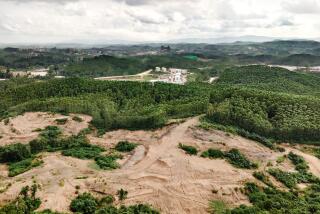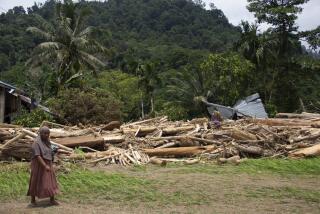The Gray Ooze That Ate the Indonesian Villages
- Share via
SIDOARJO, Indonesia — Nothing, it seems, can stop the mud.
For more than three months, the hot, noxious goop has spewed up through a crack in the earth at a natural-gas exploration site, swamping everything in its path.
The expanding, surreal gray lake with the stench of rotten eggs has enveloped more than 10 square miles of land in eastern Java, Indonesia’s most densely populated island. The flow has forced 8,000 to 10,000 people from their homes, engulfed about a dozen factories, contaminated fish farms and intermittently closed a major highway.
Confusion has reigned over how to stop it. An effort to drill a series of relief wells was slow to begin and has thus far failed. With the mud continuing to gush, emergency crews have scrambled to put up earthen barriers to contain and redirect the flow away from villages. Some of the dams already have been breached, and officials are running out of space.
In a country reeling from a string of natural disasters, this man-made fiasco has thrown a fresh, harsh light on an overwhelmed government struggling to counter accusations of corruption and ineptitude.
Nerves have frayed over the slow and uneven response to the crisis by government agencies and Lapindo Brantas, the politically connected company with a controlling stake in the exploration project. Frustration spilled over last week when displaced villagers set fire to a camp of tents used by Lapindo workers.
Suyati, who, like many Indonesians, uses one name, watched anxiously for weeks as one of the barriers held the mud at bay -- temporarily.
“It flew very fast, like a tsunami,” said Suyati, 57, recalling the day last month when the pent-up mud surged though the barrier.
“I was scared and I ran with my sick husband. My son and I had to carry him, because my husband is paralyzed. The mud was behind us.... It was hot and smelled very bad. We ran to the mosque, but the mud was very fast. All of a sudden it was up to my waist.”
It is unclear what went wrong during the drilling of a 2-mile-deep exploration well. Several environmental and community groups have accused the company of shoddy work and lax oversight, saying a protective lining that could have prevented the disaster was not properly in place.
Company officials initially suggested the mudflow had resulted from an earthquake days before, but quickly abandoned the idea.
The company has since taken responsibility for the damage but won’t say what caused it, citing a police investigation.
The disaster, and the government’s inability to cope with it, have angered residents. Their frustration has deepened with reports that Aburizal Bakrie, the government minister responsible for coordinating responses to natural and man-made disasters, owns a stake in the gas exploration project.
Adang Setiana, a deputy to Bakrie, said the government’s response had not been influenced by the minister’s connections. Bakrie is one of the country’s wealthiest men.
At the shore of the mud lake, white smoke billows ominously. Large bubbles burp at the center, marking the roughly 50-foot-wide crack, where temperatures reach about 140 degrees. Only rooftops and the tips of denuded trees poke above the surface of the mud, which is 20 feet deep in places.
Tests have found elevated levels of phenol, which can irritate human skin and cause breathing discomfort, according to a report by WALHI, a leading environmental group. There have been no reports of hospitalizations, although two people have died in accidents related to the mudflow: an emergency crew member reportedly caught in an explosion of a pent-up gas deposit and another run over by a bulldozer.
Most of the people whose houses have been inundated have taken refuge in the dreary storefronts of a recently built market, uncertain whether they will be able to return home.
On a recent sweltering afternoon, a neighbor of Suyati’s, Rois Haryanto, was trying to clear knee-high mud from his front yard while four young men he had hired worked inside. On the white wall of his home, Haryanto, 47, had scrawled, “Beware of Lapindo’s henchmen.”
“I saw them on TV promising that they will reimburse everything, every little thing,” he said angrily. “They promised that. That is why I still live here, with the mud. I don’t want to go to the [market]. This is my house, and I want them to see that.”
Rawindra, a regional manager for Lapindo, said the company had been paying displaced residents about $35 a month for living expenses, while also offering about $550 to families to cover two years’ rent and to purchase their homes from them. Many villagers, however, are reluctant to abandon the idea of going home.
“It would be easier if everybody agrees, but people have different ideas,” Rawindra said. “Some are still convinced that they can stay at their homes, so we cannot ask them to sell their houses -- even if it’s under the mud.”
The offer to buy homes has stoked the suspicions of some. They accuse Lapindo of trying to acquire the land cheaply to exploit it for the large natural gas field that is thought to lie beneath.
Energy exploration is a major industry in Indonesia. Amid declining output from many of the country’s older oil fields, the world’s energy giants are investing heavily here to find new oil and natural gas deposits.
A steady stream of elected officials, including President Susilo Bambang Yudhoyono, has visited in an effort to ease tensions and show the government’s commitment to stopping the mud.
The public relations bid, however, has failed, with Cabinet ministers clashing publicly over a contentious plan to build water treatment plants and several miles of pipelines to drain the lake into the ocean.
The whispers about possible corruption have been an added setback for Yudhoyono, who has made combating graft a focus of his first term. Despite his efforts, surveys by the World Bank and Transparency International, a German-based corruption-monitoring group, have ranked Indonesia near the bottom.
Meanwhile, the mudflow continues. The chief of one flooded village recently offered a free house to anyone who could use magic to stop the flow.
More than 60 people from around the country have tried, the chief said, but no one has succeeded.
*
More to Read
Sign up for Essential California
The most important California stories and recommendations in your inbox every morning.
You may occasionally receive promotional content from the Los Angeles Times.











